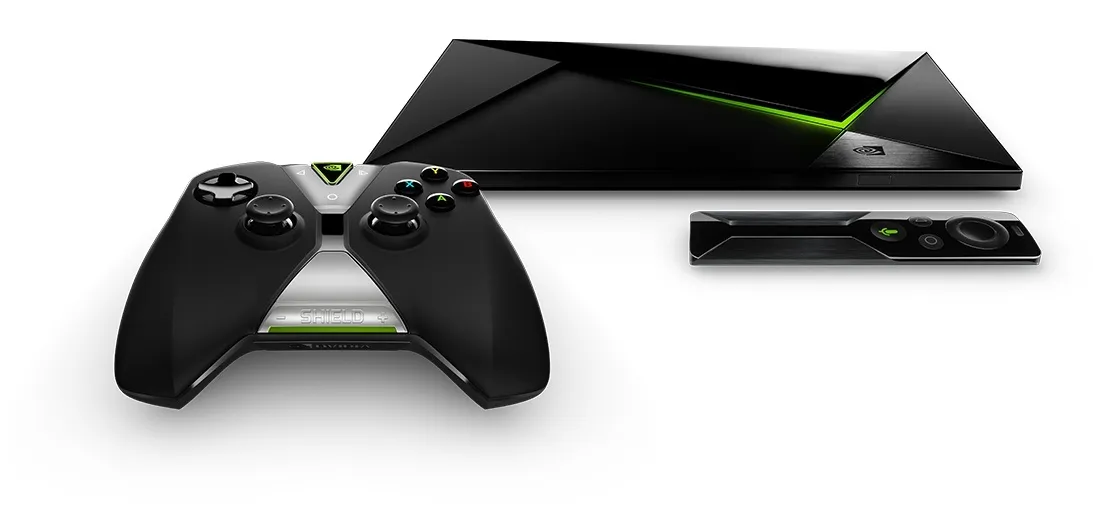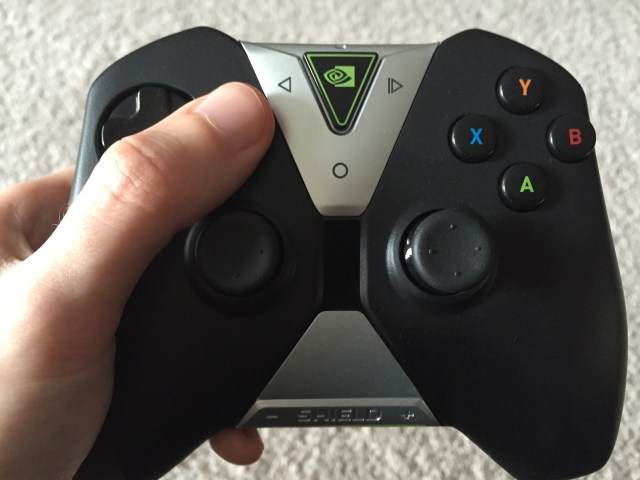In whatever form it finally solidifies and however long it takes to finally get there, streaming Internet TV is the future of television. Similarly, it seems like destiny that streaming video games will be part of our future, too. (Though maybe not all games, as genres like fighting games can suffer from any lag, no matter how small.) Or, if you can’t wait that long, they can be part of your present with the Nvidia Shield TV.
Whether or not that’s worth it to you, however, will depend on a few factors.
I haven’t had cable for a few years now, and during that time, I’ve relied on my Apple TV for most of my TV/movie entertainment. “Cord cutting” still isn’t 100% as practical as it could be, but there’s enough available to me that hanging on to cable just to watch a few things is kidding myself that I’ll even have enough time to watch them. However, my trusty little box is getting a bit dated, and a replacement with some extra bells and whistles is about due.
Enter the NVIDIA Shield TV, which essentially makes my 3rd generation Apple TV pointless. It comes with Netflix built in and also has downloadable apps for HBO Go and Hulu (the other two streaming services I personally use). There are plenty of other entertainment apps to download, including one for game-streaming service Twitch, which Apple is missing. However, it’s worth noting that if you are knee-deep in another tech company’s ecosystem, the Shield runs on Google’s Android TV (which allows plenty of customization and extra app and utility downloads). You can still play your iTunes movies and what-have-you directly from your computer using Google Cast, which worked perfectly for me in testing, but Android/Google natives will feel more at home.
Tech Specs:
PROCESSOR:
NVIDIA® Tegra® X1 processor with a 256-core GPU and 3 GB RAM
VIDEO FEATURES:
4K Ultra HD ready
4K playback at 60 FPS (VP9, H265, H264)
4K capture at 30 FPS (H264, H265)
AUDIO:
7.1 and 5.1 surround sound pass through over HDMI
High-resolution audio playback up to 24-bit/192 kHz over HDMI and USB
High-resolution audio up-sample to 24-bit/192 kHz over USB
STORAGE:
16 GB and 500 GB (Note: portion of storage occupied by system software) Expandable with microSD card or USB drive.
WIRELESS:
802.11ac 2×2 MIMO 2.4 GHz and 5 GHz Wi-Fi
Bluetooth 4.1/BLE
INTERFACES:
Gigabit Ethernet
HDMI 2.0
Two USB 3.0 (Type A)
Micro-USB 2.0
MicroSD slot
IR receiver (compatible with Logitech Harmony)
Gaming:
That said, the Shield TV is really about gaming. Those other entertainment options are there to make it a suitable gaming-oriented upgrade to your streaming box setup, but it’s clear from the moment you open the box that the Shield TV is a game machine. Inside, you’ll find the sleek, relatively small Shield TV itself, an HDMI cable (and power cable, of course), a game controller, and a USB charging cord. Yes, a controller is the default remote for the Shield TV, and that really sums up the entire product. (A more standard remote is sold separately at $49.99, though as of this writing, they’re offering a free one with purchase.)
The potential gaming library on Shield TV is built from a number of different concepts and sources. It runs a huge library of familiar Android games by mapping touch functions to controller buttons, features PC games downloadable to its on-board storage (and optional external storage with USB hard drive or micro SD), and it’s capable of streaming either games you already own from your own computer or games available from the cloud by monthly subscription to GeForce Now. (There’s a 3-month free trial to let you thoroughly test the waters.)
Each of those, of course, comes with its own ups and downs. Streaming your own games to your TV is a solid option for any PC gamer, but the hardware requirements for it are a bit specific (notably needing an NVIDIA graphics card) when you could just plug your gaming rig into your TV. Still, lots of people don’t have a high quality gaming PC (myself included), which makes GeForce Now an attractive option.
If you’re not familiar with game streaming services, the processing of a GeForce Now game is handled on NVIDIA’s servers, and then the audio and video are streamed live to your TV through Shield. It’s great in that it brings you extremely high quality graphics without a care in the world about your own system specs, but it’s also more demanding on your Internet connection than streaming high definition movies or TV, because it has to be handled 100% live so you can actually play the game. That means that if your Internet connection is the slightest bit unreliable, things can get a bit choppy. I have moderately fast Internet at 24 mbps downstream and 5 upstream, but my connection isn’t always the most stable, which led to some skipping and stuttering during GeForce Now gameplay. (I was also connected directly using an ethernet cable instead of Wi-Fi, for the curious.)
If your Internet connection is good, that won’t be a problem, and “Netflix of gaming” is a pretty accurate descriptor for the service. Even with notifications popping up that packet loss was high and my connection was lagging, I’ve played plenty of Arkham Origins and Tomb Raider—pretty standard game streaming offerings if you’ve tried such services before—through GeForce and enjoyed the experience thoroughly. However, the game selection isn’t terribly wide for the $7.99 per month fee, and newer games still require a full price purchase, on top of regular membership to be streamed. Those caveats, I’d assume, are due to the service still being in its infancy, and game selection is a frequent problem with game streaming memberships (to varying degrees) that likely won’t be entirely solved until it’s a more common way of playing games in general.
Android games work great though, and so do the downloadable PC games, though the sacrifice there is that they’re older titles. The controller itself is also a decent piece of hardware. It’s similar to an Xbox 360 controller, but the left thumb stick and d-pad are reversed. I wish they were the other way around, as I find that a more comfortable position for my hand for prolonged thumb stick use, but that’s just a personal preference. It uses capacitive touch buttons for the “back,” “start,” and “home” buttons, as well as the power button. It also features a headphone/headset jack, volume buttons, a charging port, and a microphone for use with the system’s voice search function. Holding down the “home” button brings up a menu for starting Twitch broadcasts, recording gameplay, taking screenshots, and adjusting your broadcasting options, which make for some great native functions.
Overall:
At the price of $199, Shield TV is at the high end of media box pricing—kind of. For the sake of comparison, the 4th generation Apple TV, which is geared towards iOS gaming, comes in at $149 with 32 GB (for the lower end) of onboard storage compared to the Shield’s 16 GB. However, the Apple TV doesn’t include an HDMI cable or a controller, instead opting for a remote in the box. Apple’s remote may have game control features, but it’s not the same as coming with a controller packed in, and while the Shield may come with less storage to start, it’s more flexible with 3rd party hardware, allowing its storage to be expanded. Shield also features 4k video capabilities and plenty of other options and customization that Apple’s box is lacking, and it’s also a much more powerful machine made for far more demanding gaming, which makes a direct price comparison a bit unfair.
Overall, it’s a powerful piece of hardware at a pretty fair price, but it’s also at the forefront of a new market that needs to find its early adopters. The Shield is about finding a niche. If you’ve got a large library of PC games, want to play them on your TV, and have hardware that will support it, the Shield may be a solid option. It may also be for you if you don’t already have a streaming media box (or are looking to upgrade from one you do own) and you like the idea of getting one that’ll also let you play some graphically intense games without having to buy hardware capable of processing them on its own. If you want 4k streaming capabilities and the Shield’s other features sound like fun to you, it might also be a good buy.
Ultimately, it’s not a device for everyone, but those who do fall in its specific target markets should really enjoy its capabilities. Streaming devices like this aren’t quite ready to replace game consoles just yet, but the Shield TV is another good step in that direction.
NVIDIA provided a sample unit for the purposes of this review.
—Please make note of The Mary Sue’s general comment policy.—
Do you follow The Mary Sue on Twitter, Facebook, Tumblr, Pinterest, & Google +?









